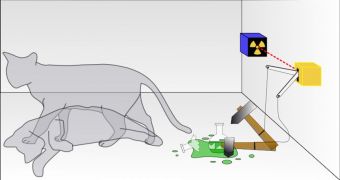One of the most basic principles in quantum physics is that an object in a closed system with no observers can exist in more than one states at the same time. This was made clear in 1935 by Austrian physicist Erwin Schrödinger, who proposed his famous cat example. Now, experts are planning to perform the same set of studies on viruses, in an attempt to determine what will happen to the organism. The investigation could also provide further clues on how to apply the method on larger living things, Nature News reports.
The international team of scientists behind the proposal, made up of experts from Spain and Germany, believe that the goal can be achieved physically, and not just in thought, as with Schrödinger's cat. They are very curious about what would happen to a virus forced into two overlapping quantum states at the same time. The team plans to use advanced lasers to make this a possibility. Though you may be tempted to believe that this is going to be easy, on account of the fact that viruses are extremely small, you are mistaking. Quantum superposition was never before proven at a scale larger than that of a single atom.
The tobacco mosaic virus seems to be the microorganism of choice for the investigators. They plan to trap it using an electromagnetic field generated by a laser, and then slow it down to its lowest possible energy state using another laser. A single photon would then set the virus in a superposition state. While no observations are made on the pathogen, it should remain suspended between two possibilities. It's only when measurements are made that superposition breaks down, and the object of the study settles in one of two possibilities.
“I'm absolutely convinced that a virus would behave exactly the same as an inorganic molecule,” says Imperial College London physicist Martin Plenio. He also suggests that this line of study may in the future offer clear knowledge of where the quantum world ends and the macroscopic world begins. And Schrödinger's experiment seem indeed like the place to start. In the words of the physicist himself:
“One can even set up quite ridiculous cases. A cat is penned up in a steel chamber, along with the following device (which must be secured against direct interference by the cat): in a Geiger counter, there is a tiny bit of radioactive substance, so small that perhaps in the course of the hour, one of the atoms decays, but also, with equal probability, perhaps none; if it happens, the counter tube discharges, and through a relay releases a hammer that shatters a small flask of hydrocyanic acid. If one has left this entire system to itself for an hour, one would say that the cat still lives if meanwhile no atom has decayed. The psi-function of the entire system would express this by having in it the living and dead cat (pardon the expression) mixed or smeared out in equal parts,” he wrote decades ago.

 14 DAY TRIAL //
14 DAY TRIAL //